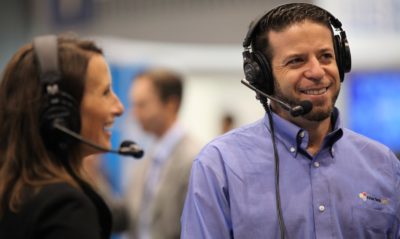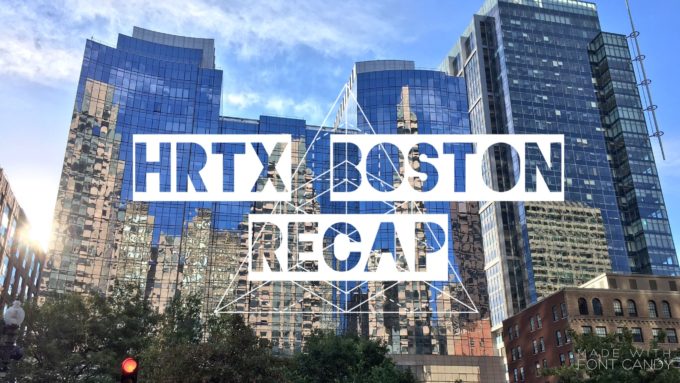The crew at Recruiting Daily has stumbled upon a pretty sweet but simple event format. As Jackye Clayton, event facilitator, put it, the team took the things they like about conferences and set aside the things they don’t in coming up with the structure of their one day HRTX series. That tells me that what they collectively like is:
- Targeted content delivered by recognized industry names
- Fast paced demos/talks with a mixture of up and coming and well-rooted software vendors
- Good food and drink
- Cool cities like my hometown of Boston
The Discussions
The day started out with a productive discussion about the challenges companies face in their recruiting efforts, led by Martin Burns and assisted by Bill Boorman and Matt Charney. One attendee wanted advice on whether her Facebook ads were working if she was getting click throughs, but a lack of applications once they arrive at the company landing page. While the concensus was “no,” it led to further insights about measuring media cost per hire and using double click tags and ads.
It’s a good time to point out that several attendees worked for big companies, like the one guy who claimed to have processed 11K hires in the past weekend (it’s a seasonal retail business, but still).
Following was a open information share about what technology stacks attendees were using. Most notable was a huge bank that had just recently gone from PeopleSoft to Taleo. Another attendee claimed to use iCIMS and while she thought it seemed like a good suite, she had some concerns about the way it was configured in her organization.
Next we moved to a discussion about the new world of employees, Bill Boorman telling us that “the Employee Value Proposition (EVP) is dead. Individual (IVP) is now more important, [and we have to decide] how we talk to you about what you want.”
We talked about talent communities…which Bill suggested could be built internally based on an Org Chart structure. Tying in the election, he suggested that “recruiting is like voting these days. People are looking for the job that’s the least shit.”
Regarding creating job descriptions, which Charney saw as a huge opportunity for contractors, the theory was that when marketing writes them, they’re not down to earth. After all, Matt said, “there’s a reason why “Our people are our greatest asset” has become the tagline for thousands of company.” The thought came to me that enabling employees to write their own job description, and that was bore out when I visited one of the technology vendors later in the day.
The next topic we covered was the fact that there’s more and more texting in recruiting. The concerns I voiced about the disruption caused by unsolicited texts were trumped (timely choice of words) by the ridiculously good response rates on texts. Apparently, Amazon recently sent 15K job-related texts at once, 14K of which were responded to. Of course nobody mentioned that the fact that it was Amazon seriously skewed the percentages, but still the audience reaction tells me we should all be expecting many more recruiting texts in the near term.
After the attendees unanimously called referrals the biggest source of hire, Bill was nice enough to point out the difference between recommendations (self-explanatory), social referrals (anyone in our n etwork) and referrals (somebody I know but I don’t know how good they are).
Vendor demo/talks
Just when what I felt was a great “round the world of talent acquisition today” discussion had wrapped up, it was time for my group to begin our twirl around the other room in roughly 9 minute (there was some variability by the chatty timekeeper) vendor demo/talks. The following are my notes.
NextWave Hire
A great continuation of the discussion just had in the other room, founder and CEO Phil Strarazzulla talked to me about ways to give people authentic looks into the company they’re considering joining. Instead of hiring Charney to write your job descriptions, you can send out surveys to your employees and then augment your careers page with that info.
Phil showed me the NextWave product and it’s 3 step process: 1) HR chooses questions that are the baseline for that job , 2) The employee answers questions 3) All that info resides on an overall site for the company, including microsites.
The goals are to create a talent community for those who aren’t ready to apply, and side benefits like pushing content to social media and other sources like universities.
Happie
Jennifer Fremont Smith described Happie as all about sourcing at the top of funnel. They nurture active candidates with their multi touch approach of letting them know about your opportunity. They use email, SMS, and some LinkedIn messaging to generate 12 touches over 12 weeks. By sindicating across many channels, their goal is to surface passive candidates and present them matched by role. The recruiter sits back and waits and at some point can opt out some people. Their point is that today’s workforce is job hoppy…so you want to keep them warm. iRobot is one of their bigger customers.
Skill Scout
I had a great talk with Abby Cheesman, which isn’t a surprise since she writes for a blog called HR Against Lame. Skill Scout shoots to let candidates experience the job before they do it and companies experience candidates. The do a lot of videos of the job experience, and even conduct pretty cool tests that includes “what’s wrong with this picture” specializations. They’ve worked with Farmer’s Fridge and Unilever, and their goal is to reduce time to hire by two-thirds.
Clinch
Shane Gray clinched the “fastest to explain his product” award by calling it Hubspot for Recruitment. Done. Next! But seriously, it sits on top of an ATS in order to more provide employer branding around job. Just like Hubspot, the goal is to give people the content so that you can see who is consuming the info. Clinch becomes the front-facing delivery mechanism, and adds other calls to action on the page such as applying (obvious) and “liking” things (less obvious). Not so shockingly, they also run email and marketing campaigns, using that data to build pipeline. In showing me the product, I was able to see the automation of social promotion and to me the most impressive pipelining visuals which looked a lot like Trello.
ClearCompany
Most notable about my conversation with Sara Pollock and Brian Campbell was that there was such a major release of their product coming the following week that they couldn’t show it in Boston. I was intrigued to see more of their talent management suite, so hopefully will get the chance when I’m back from HR Tech World in Paris.
Cornerstone
Being quite familiar with Cornerstone’s Talent Management suite, my conversation with Jon Romano was more important in order to get to know a local sales guy, which could come in handy in a future selection project. Jon did tell me about how they have a healthcare team in the Boston area as well as higher ed. Unfortunately, I couldn’t get my peepers on CSOD’s new core HR functionality, but Jon said that maybe I could do that soon.
Elevated
When somebody hands you an eHarmony business card, you know things could get interesting. According to Jane Riley, Elevated is essentially eHarmony for your compatibility and your job. They work with 100 people minimum, measuring work/life balance. Once they understand the company, then they apply that knowledge to the candidate. They focus on 16 different culture factors and she was quick to point out that sometimes candidates aren’t a great fit for the hiring manager, but they might a good culture fit. In the end, the goal is reduced turnover, having the right candidates onboard and reducing TA spend. If you’re hiring for your people it will cost you less.
Right Fit
Brittany Collazo and her colleague showed me a really cool to of filtering jobs visually using hexagons…aka hives! Their company logo is three hexagons. In other words, more to come on Right Fit from my perspective.
After a ridiculous steak and key lime pie, we resumed the content portion, honing in on diversity. Katrina Kibben delivered a nice, personalized talk about understanding diversity in order to help reduce discrimination. Her point was that you should take everybody’s story and find some way to act on it. Attendees backed that up, with a leader from Citizen’s bank talking about building relationships with people through food cultural days, which actually reminded me of one of my favorite clients on that front, Sparta Systems.
So, there you have it. Quite the day to partake in, and hopefully I’ll get the chance again in the future.

